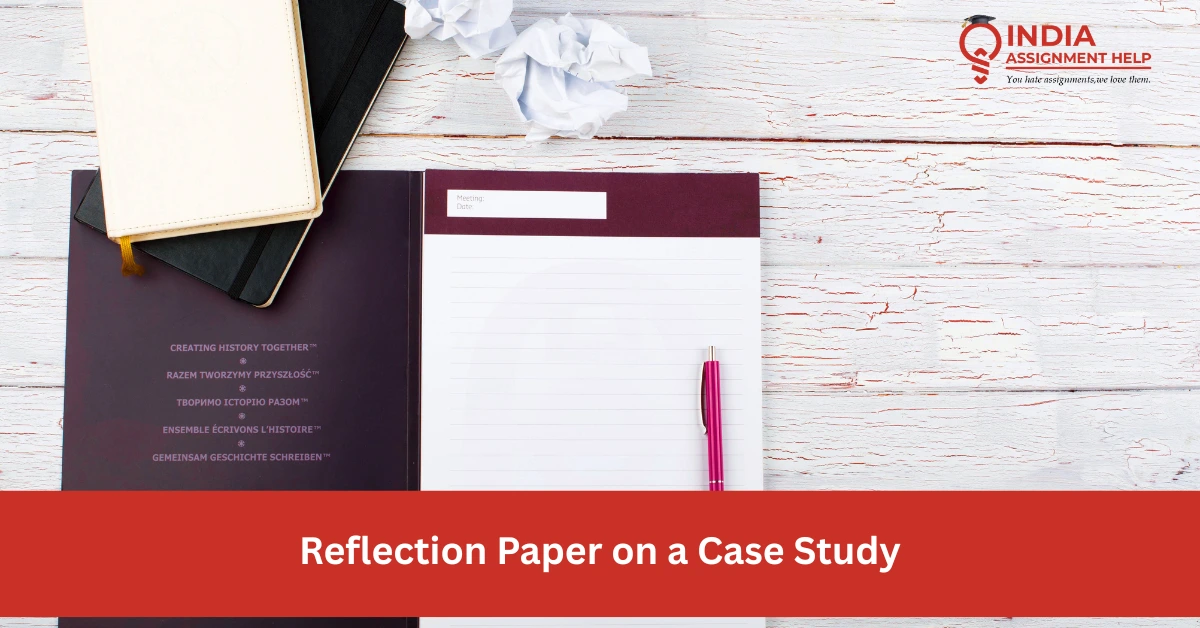How to Write a Reflection Paper on a Case Study?

Writing about your thoughts is harder than it sounds. Most students sit down to start their reflection paper on a case study, and suddenly, their mind goes blank. Not because they didn’t read the case or didn’t understand it. But they’re unsure of how to turn their personal experience and analysis into something structured and insightful.
We’re here to end this confusion. This guide will show you exactly how to write a reflection paper on a case study, step by step, with tips and examples.
What Is a Reflection Paper?
A reflection paper is a personal response to something you’ve read or experienced. In this case, it’s a case study—a detailed analysis of a person, event, company, or scenario that is used to explore real-life situations.
A reflection paper doesn’t need you to just summarize the case. It makes you connect the case to your thoughts and understanding. You can’t simply describe what happened.” You also have to explore why it mattered and how it shaped your perspective.
What Makes a Case Study Reflection Different?
Case study reflections are a bit more focused than general reflections because:
- You’re not reflecting on a theory but on a real or hypothetical situation.
- The goal here is to think critically about how the case was handled and what you would do differently or similarly if you were in the same situation.
- You don’t have to share your emotions, but discuss your learning and insights.
So, when you’re writing a case study reflection, your voice matters, but so does your ability to analyze, compare, and connect ideas.
Things to do Before Writing
You don’t have to jump straight to paragraphs when you’re writing a reflection. You have to prepare first.
Let’s see what you need to do before you start writing:
1. Read the Case Carefully
Even if you’ve read the case once, you have to read it again, and this time with a pen in hand. Make sure you highlight key points and note actions, reactions, and outcomes. You also have to pay extra attention to what challenges arose and how they were dealt with.
Ask yourself these questions:
- What were the main issues?
- Who was involved?
- What decisions were made?
- What theories or concepts does this relate to?
2. Identify Your Reaction
Now reflect on how you felt when you read the case again.
- How did the case make you think differently?
- Did it challenge your assumptions?
- Did it confirm something you’ve experienced before?
Take a moment to think deeply about these questions, and then start noting down your thoughts in raw form. These thoughts are the seeds of your reflection.
3. Review Related Class Material
The last step is to refer back to your classroom materials. Check if any theories, readings, or models from your course relate to the case. This will help you ground your reflection in an academic understanding of your field.
How to Structure a Reflection Paper on a Case Study
A reflection paper without a structure is like a ship without a compass. If you don’t have a structure in place, you can lose your readers. Even though a reflection is personal, it shouldn’t feel like a diary entry. You can follow this format to structure your paper:
1. Introduction (10–15%)
This is where you set the stage for your entire paper.
You can include:
- A brief overview of the case study (1–2 lines only)
- The purpose of your reflection
- A thesis statement that outlines your main insight
Example: “The case study on XYZ Company’s failed product launch highlights critical gaps in cross-functional communication. This reflection explores how poor internal alignment impacted strategy execution and what I learned about leadership accountability in such contexts.”
Keep your introduction concise and clear.
2. Summary of the Case (15–20%)
The next step is writing a summary that briefly describes the situation. You don’t need to retell the entire case. Just focus on the parts relevant to your reflection.
You have to include:
- Key events
- Stakeholders
- Decisions made
- Outcomes
Make sure this section sets up what you’re going to reflect on in your paper.
3. Reflection and Analysis (50–60%)
This part is the heart of your paper, so when you are writing, spend most of your time here. You can break this section down into clear points or themes, with each paragraph covering one insight or angle.
Let’s see what you can include in the Analysis of your reflection paper:
- Your interpretation of the events
- What went well or what went wrong
- How it connects to theory or real-world practice
- What you would do differently and why
- What you learned from the situation
Examples:
- If you’re in nursing: “ This case reminded me of Gibbs’ Reflective Cycle, particularly the 'evaluation' phase, as I assessed how the nurse’s decision impacted the patient’s long-term recovery.”
You can use models, course material, or frameworks to support your reflection. But don’t just name theories just for the sake of it; explain how they apply to the case.
4. Conclusion (10–15%)
Your conclusion should wrap up your reflection and leave the reader with a final thought.
In conclusion, include:
- A restatement of your key learning or insight
- Why this reflection matters
- How it might shape your future behavior, studies, or career
Example: “This reflection reinforced the importance of proactive communication in high-stakes environments. Going forward, I plan to apply structured communication tools like SBAR to avoid ambiguity and ensure better team collaboration.”
Your conclusion should feel like a takeaway and not just a summary. You mustn’t state any new facts or opinions in this section.
Dos and Don’ts of Reflective Case Study Writing
Do:
- Use first-person language (“I,” “my”) when appropriate.
- Be honest but respectful.
- Link your insight to academic ideas or professional standards.
- Keep your tone academic and yet clear.
- Proofread carefully for grammar and flow.
Don’t:
- Simply summarize the case without any analysis of your own.
- Turn the reflection into a rant or emotional outpouring.
- Use casual language or slang.
- Ignore relevant course material or theories.
- Forget to stay focused on the case study
Reflection as a Learning Tool
Sometimes, students treat reflective writing like a formality. But in reality, it’s one of the most powerful learning tools you have. When you reflect on a case study, you're building your ability to:
- Think critically
- Make connections
- Apply theory to practice
- Develop professional judgment
These are real skills that matter in the workplace and will help you progress in your career.
Assignment Help To Write a Reflection Paper
Writing reflective papers isn’t as easy as people make it out to be. It gets complicated if you’re unsure about details like how much personal voice to include or how to structure it. If you also don’t know how to write a reflection paper on a case study, it’s okay to reach out for support.
Many students use assignment help platforms because they want to learn how to do it better. Our case study help services guide you on tone, structure, and referencing, and even give feedback on drafts.
Final Thoughts
We hope this guide helped you understand how to write a reflection paper. It’s easy if you follow all the steps and start a bit early. It’s important that you’re being thoughtful, clear, and honest in how you process a real-life situation.
If you follow all the steps and explain how the case changes your perspective, then you’ve already written a successful reflection. If it still feels overwhelming, you just have to reach out to our assignment help services, and we’ll be more than happy to assist you.





